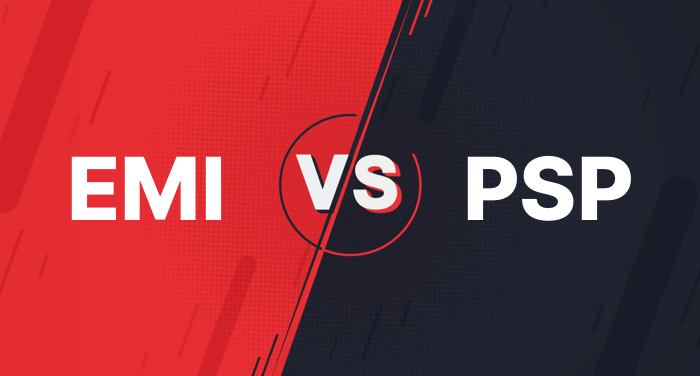One of the first decisions every company considering to enter the payment industry must make is to seek an Electronic Money Institution (EMI) licence or operating as a Payment Service Provider (PSP).
Both have their own set of standards that businesses must consider based on the services they wish to provide to their clients. The starting capital needs for each, for example, are vastly different. Similarly, the types of payment account that businesses can provide their clients differ.
It gets trickier when there is so much information available that deciding where to begin can be difficult. To simplify, we'll go over the various licences, their requirements, and the services they empower businesses to provide.
What Is a PSP?
A Payment Service Provider (PSP), often known as a merchant service provider, assists merchants in accepting payments by debit or credit cards, as well as bank transfers. To do so, they usually give merchants a merchant account and a payment gateway via which they can collect payments.
A Payment Institution (PI) is a payment service provider often known as the Payment Services Directive (PSD). PSD2 and its national implementation by the EU Member States now control the activity of payment institutions.
Payment institutions can provide the following services to their consumers under PSD2: payment transaction execution, which includes credit transfers, direct debits via payment cards, similar devices, payment instrument issuing or acquisition, money remittance services, and the provision of credit.
Payment institutions, in general, can offer the same services as electronic money institutions. Payment institutions are unable to issue electronic money, which is the main distinction between the two.
What Is an EMI?
A corporation or organisation that has the authority to issue electronic money in line with a specific EU Member State's implementation of Title II of Directive 2009/110/EC, also known as the Electronic Money Directive 2, is an electronic money institution (EMI).
Electronic money institutions can issue electronic money in addition to the services provided by regular PSPs. The account holder then has a claim against the issuing institution for the amount in the account, and the account holder can use the account as a payment instrument to make purchases.
Electronic money institutions can also provide payment services as defined in Annex 1 of the Payment Services Directive 2 (PSD2), commonly known as Directive (EU) 2015/2366.
These services include payment transaction execution, currency exchange and conversion services, safekeeping operations, data storage and processing, or payment service operation defined in Article 18(1)(b) of the PSD2.
It's worth noting that not all EMIs can provide all of these services because not all EMIs are automatically authorised to do so when a licence is issued. It's also crucial to know which payment services are tied to e-money issuing and which are unrelated. This is because the prudential criteria for linked and unrelated electronic money transfer services differ.
What is Electronic Money?
To appreciate the distinction between EMIs and PIs, it's necessary first to comprehend what electronic money is.
According to the European Central Bank (ECB), electronic money is a monetary value held electronically, such as on a card, phone, or the internet. It is a claim against the electronic money's issuer.
A magnetically stored monetary value that may be used as payment and is maintained by entities other than the issuer is included in the EMD2 definition of electronic money. As a result, the gadgets that store the monetary value must be widely accepted as a payment mechanism.
In simple words, electronic money is a digital replacement for currency, according to these definitions.
As a result of the previous, any company or organisation that wishes to issue an instrument that meets the definitions above of electronic money must apply for an EMI licence. There are a few additional differences between the two as discussed below -
Accounts
According to Article 4(12) of PSD2, a payment account is used to make payments in the name of one or more users of a specific payment service. According to Article 2(3) of Directive 2014/92/EU, a payment account is held in the name of one or more clients and used to perform payment transactions.
A payment account is used for payment transactions, according to these definitions. It's worth noting that EMIs, PIs, and banks can all offer payment accounts to their consumers. The functionality of these accounts, on the other hand, varies depending on the institution.
When an EMI registers an e-wallet for a user, the user is free to use the e-wallet as they see fit, including withdrawing funds, making purchases, paying bills, and transferring funds to other bank accounts. Electronic money saved in an e-money account cannot be utilised by any non-electronic methods, distinguishing it from a deposit-taking account with a bank.
The difference between a payment account with a payment institution and one with a bank or an electronic money institution is that the payment account with a payment institution is much more limited. This is because monies must be transmitted to a payment processor for an identified transaction.
In basic terms, when money is transferred to a payment account held by a payment institution, that money must be accompanied by a specific payment transaction. This means that a payment institution cannot store money on an account holder's behalf like an electronic money institution.
Initial Capital Requirements
Payment institutions have considerably lower initial capital requirements than electronic money institutions because they cannot store money on behalf of account holders and must transfer money into the account through an identified transaction.
Article 7 of PSD2 stipulates that payment institutions must have an initial capital of EUR 20,000 if they only provide money remittance services EUR 50,000 if they only provide payment initiation service, EUR 125,000 if the payment institution exclusively provides the services indicated in Annex I of PSD2.
Payment institutions must hold funds equal to or above the initial capital needs based on the services they plan to offer, in addition to the above initial capital requirements. On the other hand, electronic money institutions are required by Article 4 of the EMD2 to have a starting capital of EUR 350,000.
Licensing Costs
There is a variation in the different application costs that must be paid and the beginning capital and other capital requirements connected to the licencing of electronic money institutions or payment institutions.
Let's take a closer look at these application fees in this section. The following is a list of the application fees for several countries:
- Great Britain -The application fee for an EMI licence in the United Kingdom is GBP 5,000, while a PI licence varies between GBP 1,500 and GBP 5,000.
- Germany - In Germany, the application fee for an EMI licence is EUR 11,900. When only one payment service is offered, the application charge for a PI licence is EUR 6,150, and when multiple or all payment services are given, the application fee is EUR 8,515.
- Lithuania -The application fee for an EMI licence in Lithuania is EUR 1,463, whereas the fee for a PI licence is EUR 898.
- Luxembourg - The application fee for an EMI or PI licence in Luxembourg is EUR 15,000.
- The Kingdom of the Netherlands - In the Netherlands, the application fee for an EMI or PI licence is EUR 6,800.
- Belgium - The application fee for an EMI licence in Belgium ranges from EUR 1,500 to EUR 4,500 for each payment service. A PI licence application cost of EUR 1,500 is required.
- Cyprus - In Cyprus, the application fee for an EMI or PI licence is EUR 5,000.
- Czechoslovakia - In the Czech Republic, the application fee for an EMI or PI licence is EUR 1,850.
- Estonia - In Estonia, the application fee for an EMI or PI licence is EUR 1,000.
Electronic money institutions and payment institutions must follow the special safeGuardiang measures set out in EMD2 and PSD2. Payment institutions that provide payment initiation or account information, on the other hand, are not subject to any safeGuardiang obligations.
Furthermore, cash received by electronic money institutions for services linked to e- money issuance and unrelated payment services cannot be held in the same safeguarded account.
It can be challenging to navigate the EMI and PI landscape. Finally, which position to apply for is determined by the company's goals and requirements. A PI licence, for example, would be the best solution if the company wishes to offer payment services. Similarly, an EMI licence would be ideal for a company that wishes to issue electronic money and give its customers the option of opening an account.













